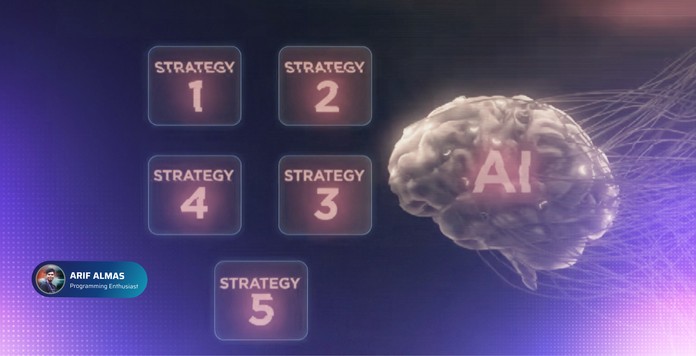AI SEO Strategy 2026: Stay Visible in the Generative Search Era

AI SEO Strategy In 2026, most searches will be answered by AI before users even click on your website. That means even if you rank #1 today, your traffic could drop tomorrow.
But here’s the good news - SEO isn’t dead, it’s evolving.
To win in this new AI-driven world, you need to optimize not just for search engines, but for AI systems that quote, summarize, and cite your content.
In this blog, we’ll explore five proven AI SEO strategies for 2026 to help your content rank, stay relevant, and convert in the new era of AI-powered search.
📌 Key Takeaways
- Focus on entities and topical depth, not keyword stuffing.
- Build E-E-A-T with real authority and brand credibility.
- Optimize for AI summaries and featured snippets.
- Use structured data and schema for machine readability.
- Track AI visibility metrics and citations, not just rankings.
1. Focus on Entities and Topical Depth - Not Just Keywords
In traditional SEO, repeating keywords was the game. But AI search engines like Google’s AI Overviews, ChatGPT, and Perplexity no longer reward that.
They care about topical depth and entity connections - how concepts, ideas, and subtopics link together.
Example:
If your main page is “The Complete Guide to Running Shoes,” you should interlink pages like:
- Best Running Shoes for Flat Feet
- Trail Running Shoes
- How Cushioning Prevents Injuries
This inner linking signals to AI that you understand the topic holistically — building Topical Authority, which is now a stronger ranking factor than keyword density.
Pro Tip: Use tools like Google NLP API or Surfer SEO to discover semantic keywords, entities, and relationships around your main topic. Check out Ubersuggest for tracking AI citations.
2. Build Author & Brand Authority (E-E-A-T for AI)
Even the best-written content can fail if AI doesn’t trust you.
AI systems prioritize Experience, Expertise, Authoritativeness, and Trustworthiness (E-E-A-T) when deciding what to quote or cite.
Here’s how to strengthen yours for AI SEO Strategy:
- Show real experience: Add author bios, credentials, and case studies.
- Earn brand mentions: Get featured on podcasts, blogs, and industry news sites even unlinked mentions help build your authority footprint.
- Stay consistent: Use the same author name, bio, and tone across your site, YouTube, and LinkedIn.
When AI platforms verify your credibility, they start quoting your content more often - giving you visibility beyond traditional search rankings.
AI doesn’t just ask “what does this page say?” - it asks “who said it, and can I trust them?”
3. Optimize for Featured and Summarized Results
AI-powered search tools don’t list 10 blue links anymore — they summarize.
That means your content must be easy to quote, summarize, and parse.
How to Optimize:
-
Write like you’re answering a question.
Example:“What are the best SEO tools for beginners?”
Answer: Ahrefs, SEMrush, and Google Search Console are beginner-friendly and scalable tools for SEO growth.

-
Use short paragraphs and subheadings.
If a human can skim it, AI can summarize it. -
Target ‘People Also Ask’ questions.
These often feed AI summaries — giving you citation opportunities. -
Focus on facts, comparisons, and stats.
Google’s AI Overviews tend to cite factual, comparison-based content.
Insight: You may not get traffic from AI tools directly — but citations drive brand visibility and high-intent conversions later.
4. Feed the Machines — Structure Your Data
AI doesn’t pick the best content automatically. It picks the clearest.
That’s why structured content wins.
If your article reads like a clean, labeled “book” with organized sections, schema, and visuals — AI systems understand it better and quote it confidently.
Practical Steps:
- Use Schema Markup: Add FAQ, HowTo, and Review schema to clarify intent.
- Add Multiple Formats: Use videos, images, or infographics. AI prefers multimodal content.
- Make Data Explicit: Use bullet points, numbered lists, and statistics.
Schema is like a nutrition label for your content - it helps machines “digest” your material faster.
5. Rethink Your SEO Workflow for Generative Search
Traditional SEO reports focus on rankings and traffic.
In 2026, your new KPI is AI visibility - how often your brand is referenced or cited by AI platforms.
Watch This Video
Modern Workflow for AI SEO Strategy:
-
Track AI citations:
Use tools like Ubersuggest’s AI Visibility Report to see how often your content is mentioned by AI systems. -
Test AI summaries:
Paste your blog into ChatGPT or Perplexity and ask:“Summarize this article.”
If AI misses key points - rewrite for clarity and structure. -
Create recognizable brand patterns:
Develop signature frameworks, terms, or visuals that AI can associate with your brand identity. -
Keep Blogging Consistently:
AI platforms still cite blogs more than any other source - especially those with consistent publication patterns.
Blogging isn’t dead - it’s the new bridge between search engines and AI systems.
Final Thoughts
SEO is evolving into AI SEO, where authority, structure, and clarity matter more than backlinks or keyword density.
The brands that adapt early will lead the next era of search visibility.
It’s not about chasing traffic anymore - it’s about training AI to learn from you, not your competitors.
Summary
In 2026, traditional SEO alone won’t guarantee visibility. This blog breaks down a proven AI SEO strategy for 2026, showing how to build topical authority, create structured and AI-parsable content, leverage E-E-A-T, use schema and multimodal formats, and track AI citations. By following these AI SEO strategy steps, your content becomes the trusted source that AI platforms quote, ensuring higher visibility, credibility, and conversions in the new era of generative search.
Check out Blog's for more technical updates.